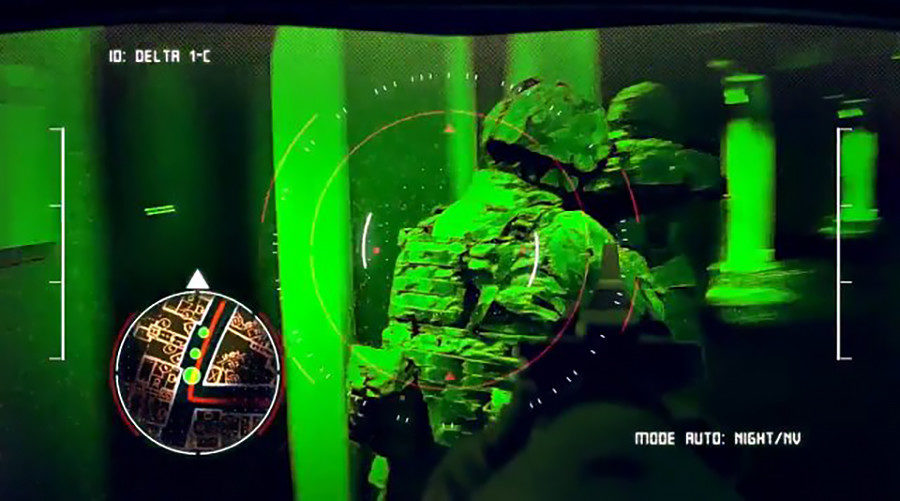During last week's Pentagon Lab Day in Washington, DC, the Army's Communications Electronics Research, Development and Engineering Center (CERDEC) and Army Research Lab (ARL) demonstrated the current prototype of their Tactical Augmented Reality (TAR) heads-up display that would give soldiers "situational awareness" on the battlefield.
The technology adds artificial elements such as icons and graphics on top of what a soldier would normally see and provides them with real-time information such as maps, navigation and the locations of enemies and friendly units, all through the Heads Up Navigation, Tracking and Reporting (HUNTR) system.
The Army hopes the technology will increase a soldier's ability to maneuver the battlefield more effectively and hopefully save lives.
Comment: Or kill people more efficiently. Either one.
Richard Nabors, an associate for strategic planning at US Army Research, says TAR will eventually replace a soldier's standard GPS and night vision devices.
Currently, a soldier's GPS only works if the device is geo-registered to their location. Geo-registration aligns the soldier with their environment which the TAR software does the automatically, Nabors said.
Staff Sgt. Ronald Geer, a counterterrorism non-commissioned officer at CERDEC's Night Vision and Electronics Sensors Directorate, said TAR will also replace a soldier's night vision goggles so soldiers will no longer need to look down at their GPS device.
The system uses an eyepiece in the soldier's helmet, which means that TAR can be used in the day or the night, without requiring the soldier to make any adjustments.
In addition, the HUNTR system has an eyepiece connected to a soldier's weapon, which allows them to see an image of what the gun is pointing at. Sensors in the system would provide the soldier with additional details, such as the distance of the target. Those images can then be sent to other members of their team through a wireless system.
The eyepiece is also designed to be split screen - so a soldier could point their gun in the opposite direction they are walking and see behind himself, or, a soldier could point their gun around a corner to see what is on the other side without exposing themselves, Geer said.
The Pentagon's Defense Advanced Research Projects Agency (DARPA), CERDEC and ARL have all been trying to develop the technology behind the HUNTR system since the 1980s.
In 1991, a program called Land Warrior emerged when an Army study group recommended the service "look at the soldier as a complete weapon system." They were awarded a contract and built a system that allowed commanders to track where troops were in real time.
However, the cost of 40 pounds of extra gear skyrocketed past $85,000 per soldier and the program was canceled in 2007.
The program was only saved when the Army began using off the shelf commercial products such as Google Glasses and smart phones which brought the price down. That project, known as the Nett Warrior, was also canceled but each subsequent project gave the Army a platform to continue working on the system that was unveiled last week.
David Fellowes, an electronics engineer at CERDEC, said the latest big challenge was making a high-definition image small enough to fit into a soldier's eyepiece. They finally made the breakthrough in 2010, when they were able to compress the image to a one-inch square, but only in black-and-white or monochrome. Those versions have been field tested, Fellowes said.
CERDEC is currently working on more advanced versions that are in full color and with augmented images that are visible in daylight. A 2015 presentation from CERDEC shows they have been using a software package known as the ARC 4.
The ARC technology provides soldiers with a compass that shows points of interest along with their distance. Soldiers are able to send each other text messages or create markers that are automatically displayed on their team's headsets.
Fellows said that TAR's will "provide Soldiers with a much higher level of situational awareness than they currently have," adding, that he "fully expects that the devices will save lives and contribute to mission success."




In this black mirror episode you learn of the dangerous implications of the technology.